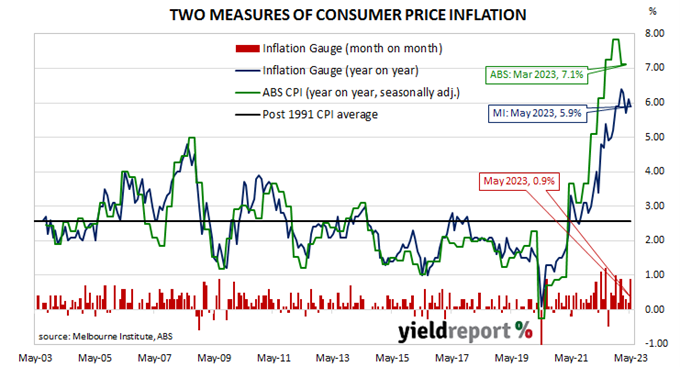Summary: Melbourne Institute Inflation Gauge index up 0.9% in May; up 5.9% on annual basis; Citi: inflation remains sticky; ACGB yields up significantly; rate cut expectations deferred until second half of 2024.
The Melbourne Institute’s Inflation Gauge is an attempt to replicate the ABS consumer price index (CPI) on a monthly basis. It has turned out to be a reliable leading indicator of the CPI, although there are periods in which the Inflation Gauge and the CPI have diverged for as long as twelve months. On average, the Inflation Gauge’s annual rate tends to overestimate the ABS rate by around 0.1%, at least until recently.
The Melbourne Institute’s latest reading of its Inflation Gauge index indicates consumer prices increased by 0.9% in May, following increases of 0.2% and 0.3% in April and March respectively. The index rose by 5.9% on an annual basis, down from April’s figure of 6.1%.
“On balance, inflation remains sticky and, on our mapping, the May Inflation Gauge corresponds with a 1.4% increase in ABS Q2 CPI,” said Citi economist Josh Williamson. “This would produce 6.6% year-on-year growth, higher than the RBA’s 6.3% forecast.”
The figures came out on the same day as ANZ’s latest Job Ads report and Commonwealth Government bond yields increased significantly on the day, generally outpacing upward movements of US Treasury yields on Friday night. By the close of business, 3-year, 10-year and 20-year ACGB yield had all increased by 14bps to 3.57%, 3.79% and 4.18% respectively.
In the cash futures market, expectations regarding rate cuts in 2024 have been deferred until the second half of the year. At the end of the day, contracts implied the cash rate would rise from the current rate of 3.82% to average 3.915% in June and then to 4.025% in July. February 2024 contracts implied a 4.115% average cash rate while May 2024 contracts implied 3.975%, 16bps more than the current rate.
Central bankers desire a certain level of inflation which is “sufficiently low that it does not materially distort economic decisions in the community” but high enough so it does not constrain “a central bank’s ability to combat recessions.”


